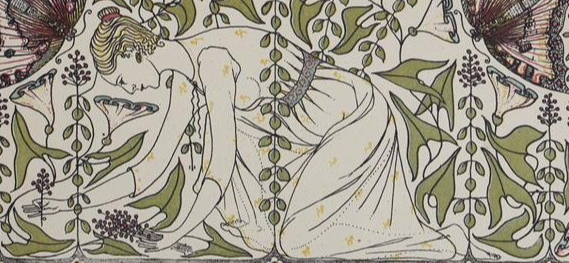You still have almost a couple of months to visit the interesting exhibition about Art Nouveau in The Netherlands.
At the turn from the 19th to the 20th Centuries many artists and designers were seeking new styles and forms of expression. After a century of styles that quoted the past, a new stylistic language was emerging, based on fluid lines and organic decorative motifs. In the Netherlands, Art Nouveau expressed a desire to innovate, a sense of idealism – and a quest for authenticity that set it apart from its French and Belgian equivalents. In this interdisciplinary exhibition, the Gemeentemuseum presents some 350 examples of decorative arts objects, including posters, ceramics and metalwork.
Holland had its Art Nouveau period but the style was subdued. Moreover, not much remains and plenty architectural traces continue to be obliterated during ‘renovations’.
Searching for architectural traces in towns and looking at work displayed in this exhibition, one can not but conclude, the Dutch version is closer to German Jugendstil and Austrian Secession, than the exuberant versions of Belgium or France.
Find out more about the exhibition in our previous note published in January 2018, which already linked to the Den Haag museums website.
The Amsterdam School can look hyper-modern yet curiously medieval. And, at its most creative, it can be utterly, infectiously bizarre.
ery often, books about European Art Nouveau do not cite the Netherlands as a major center. I am still wondering why. The wonderful work of the Amsterdam school of architecture in the 1920ies may have eclipse Art Nouveau when at the same time everywhere the Art Nouveau was forgotten or blamed? As a matter of fact, many Art Nouveau buildings remain in the Netherlands and Den Haag is one of the european city with the most important number of such buildings.
The quality of decorative arts is also stunning. Numerous firms adopted an Art Nouveau (Niewe Kunst in Dutch) design at the end of the 19th century. For instance the firm Rozenburg in the Hague (Den Haag) that invented the eggshell porcelain and is well known for its floral designs. Purmerend, Zuid Holland are also some famous Art Nouveau porcelain firms.
The buildings date from the years around the First World War until about 1930. They are mostly executed in brick and, with a few notable exceptions, found in Amsterdam. This was not a creative moment that punctuated city streets with a few recognisable and lavish landmarks but rather one that created entire neighbourhoods, huge new chunks of city, in a style that was coherent without being monotonous or repetitive: brilliantly planned, beautifully executed and elegant quarters that stand remarkably intact and work as well today as they did a century ago.
The Netherlands never really succumbed to art nouveau, as neighbouring Belgium did. Instead architects looked to England, to the simplicity and craftsmanship of Arts and Crafts, to the national romanticism emerging in the Scandinavian countries, and to their own traditions of quirky brick construction.
During the First World War the Netherlands was neutral; construction continued and the architecture developed, helped by a 1901 housing act that initiated huge slum clearances, and by commissions from the ministry of housing and construction and from the ministry of public works. The latter employed young Amsterdam School architects to design everything from street furniture and bridges – Piet Kramer designed an astonishing 500 new bridges, more than 200 of which were built – to municipal schools and swimming pools.





